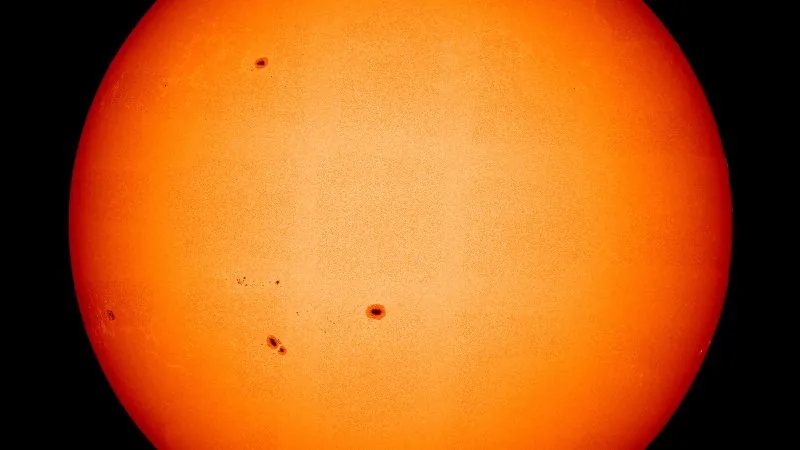
Solar Orbiter Reveals Stunning New Views of the Sun's Dynamic Surface
2024-11-20
Author: Jia
Exciting news for space enthusiasts!
The Solar Orbiter mission has released breathtaking images that provide unprecedented high-resolution views of the sun's surface activity. Captured on March 22, 2023, these images are key to unlocking some of the sun's deepest mysteries, showcasing sunspots and the mesmerizing movement of charged gas known as plasma.
State-of-the-Art Technology
Using state-of-the-art technology, the Solar Orbiter— a collaborative venture between the European Space Agency and NASA— is revolutionizing our understanding of the sun like never before. Orbiting the sun at an average distance of 26 million miles (42 million kilometers) since its launch in February 2020, the spacecraft used its Extreme Ultraviolet Imager (EUI) and Polarimetric and Helioseismic Imager (PHI) to capture stunning snapshots from a staggering 46 million miles (74 million kilometers) away.
High-Resolution Maps and Solar Dynamics
The high-resolution maps produced by the PHI instrument reveal intricate details of the sun's surface magnetic fields and hint at the complex interactions within the sun’s hotter outer atmosphere, known as the corona. Daniel Müller, the project scientist for Solar Orbiter, expressed his enthusiasm about the data released, stating that the new images are essential for understanding both the beauty and the behavior of the sun’s surface and its magnetic realm.
Remarkable Discoveries
Among the remarkable discoveries in the new images is the detailed observation of sunspots—dark regions that indicate areas where the sun's magnetic field is particularly strong and disrupts the normal flow of solar radiation. These features can be massive—often larger than our planet—and provide essential information regarding solar activity. The latest images also feature full views of the sun's photosphere, the layer from which nearly all sunlight emanates and that exhibits striking temperatures ranging between 8,132 to 10,832 degrees Fahrenheit (4,500 to 6,000 degrees Celsius).
The Sun's Magnetic Field and Solar Activity
A key takeaway from these observations is the vital role of the sun's magnetic field. The interactions of these magnetic fields with the hotter plasma beneath and above the photosphere can lead to solar flares and coronal mass ejections that have profound effects on space weather and Earth's technologically driven infrastructure.
Coinciding with Solar Maximum
Moreover, this exciting period for solar research coincides with the sun's solar maximum— the peak of its 11-year activity cycle. As solar activity rises, scientists at NOAA, NASA, and the international Solar Cycle Prediction Panel confirm that we’ve entered a phase where increased sunspots will have ramifications like geomagnetic storms, which can interfere with telecommunications and power grids on Earth.
Upcoming Opportunities for Solar Study
Mark your calendars! On December 24, the Parker Solar Probe is set to achieve an incredible feat: it will glide within just 3.86 million miles (6.2 million kilometers) of the sun's surface, providing opportunities to study solar phenomena at their source. This close encounter will allow scientists to sail through plasma plumes and solar eruptions, enhancing our understanding of solar dynamics and their impacts on space weather.
Conclusion
In summary, the Solar Orbiter’s awe-inspiring revelations are more than just stunning images; they signify a pivotal moment in space exploration that could redefine our comprehension of our solar system’s very own star. Are you ready for a deeper dive into the sun’s secrets? Stay tuned, as the Solar Orbiter and Parker Solar Probe continue their ambitious quests to shed light on our magnificent sun!




 Brasil (PT)
Brasil (PT)
 Canada (EN)
Canada (EN)
 Chile (ES)
Chile (ES)
 España (ES)
España (ES)
 France (FR)
France (FR)
 Hong Kong (EN)
Hong Kong (EN)
 Italia (IT)
Italia (IT)
 日本 (JA)
日本 (JA)
 Magyarország (HU)
Magyarország (HU)
 Norge (NO)
Norge (NO)
 Polska (PL)
Polska (PL)
 Schweiz (DE)
Schweiz (DE)
 Singapore (EN)
Singapore (EN)
 Sverige (SV)
Sverige (SV)
 Suomi (FI)
Suomi (FI)
 Türkiye (TR)
Türkiye (TR)